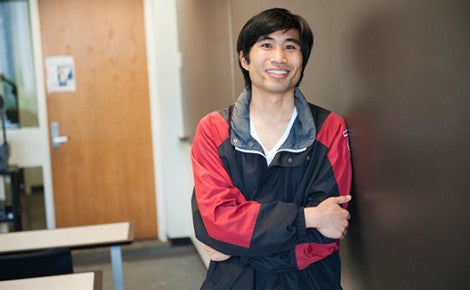May 27, 2015 — Francisco Cai could have parlayed his Stanford computer science degrees into opportunities developing a smartphone app or increasing a website’s ad revenues. Instead, he sought out a way to use his formidable coding skills to tackle problems affecting more of the world’s population. After working in a hospital for a year translating electronic medical records into usable datasets for researchers, Cai entered Harvard T.H. Chan School of Public Health in 2013. He’s graduating this month with a master of science degree in epidemiology after helping move forward an innovative idea for fighting one of the world’s most notorious insects — the malaria-transmitting mosquito.
“I didn’t know much about malaria before I came here,” Cai said, “but the more I learn the more interesting it becomes.” Tackling the disease is a challenge, he said, and it has required him to learn more than he ever thought he’d have to know about its pesky vector.
For his thesis, Cai worked on a mathematical model to test whether an experimental chemical compound could potentially disrupt the female Anopheles mosquito’s mating and reproductive process and, consequently, reduce malaria transmission. Developed in the lab of Flaminia Catteruccia, associate professor of immunology and infectious diseases, the chemical would be applied to bed nets in malaria-prone areas. If successful, it would trick female mosquitoes — who only mate once — into thinking they’ve already done the deed. Lab tests were promising, but the researchers wanted to know what would happen in a natural environment. Before taking the compound into the field, the Catteruccia lab called on Cai and colleagues at the Center for Communicable Disease Dynamics to model its potential effects.
Working with advisor Caroline Buckee, assistant professor of epidemiology, and Lauren Childs, a post-doctoral researcher, Cai started with a simple question: How do mosquitoes spend their days? For the purpose of the model, an estimate was good enough. So he mapped out a schedule for each phase of the mosquito’s life cycle: one day to mate, one day to lay eggs, and so on. He then factored the compound into the model, demonstrating how it would affect the mosquito at each stage.
The model showed that the compound did decrease the mosquito population at certain doses. And it revealed an unexpected consequence — older mosquitoes were dying off at higher numbers. This is significant for malaria transmission because the parasites that cause the disease need time to mature inside their mosquito hosts. Fewer older mosquitoes means fewer malaria parasites — findings that suggest that this method of malaria prevention is worth pursuing.
Cai will return as a researcher in the Center for Communicable Disease Dynamics after graduation. Beyond that, his path is unclear. Although he had long considered medical school, Cai’s time studying public health has opened him up to other possible careers.
He’s grateful that he had the opportunity to learn how a research idea is developed and tested from Buckee, who wooed him to the School when he was applying. The idea of conducting his own research has intrigued him since his time working at Children’s Hospital in Los Angeles. There, he developed software tools to pull together medical records from different sources into datasets for researchers. That data was often messy, with different providers using different names for the same medical measurements.
Back then, Cai found himself growing more interested in how researchers would be using the data. “I wanted to be the one asking the questions,” he said. “And now I am closer to that goal.”
Photo: Emily Cuccarese
